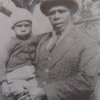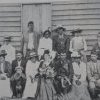1880s
1880
Groups of Koori people from outside Sydney are living in Sydney, from the Illawarra region, the Burragorang Valley and the Hunter River. The Illawarra people often camp at La Perouse, the others camp in the boat sheds at Circular Quay near the site of the Opera House. These people are drawn to the city because they are suffering increasing poverty and dislocation on their own lands. Their demands for land and boats attract as much attention as their drinking. Goodall, Invasion to Embassy, p 89.
1881
The missionary Matthews, with the approval of the NSW State Government, rounds up Koori people from La Perouse and Georges River and takes them to his mission station Maloga on the Murray River. Goodall and Cadzow, p. 113. The people include Ellen (Biddy Giles’s daughter). Eventually she returns with her family to live in Kangaroo Valley and by 1910 they are living near Botany. About this time they move upriver to camp and later buy land on the lower Salt Pan Creek where it flows into the Georges Creek. Goodall and Cadzow, Rivers and Resilience, 114 -115
1882
Thornton defends allowing the Aborigines camp to remain at Botany Bay and North Head. "I found some of them settled at La Perouse and [they] were anxious to remain there… the men are all young, strong, intelligent (some able to read and write), able and willing to work – they are nearly all half-castes with half-caste wives and a number of children."
1883
Describing La Perouses' origins, a writer in the Sydney Morning Herald claims: “It has long been used as a halting place for Aborigines since Captain Cook’s time and probably before. But about 4 years ago [1879] George Timbery found the camp deserted and settled down there with his wife and family. He is joined by other families and now they form a little village. By this, it means the place seems to have become a permanent settlement."
The Aborigines Protection Board is established. The chairman, George Thornton, wants to clear some Sydney regions of Koori people, for instance, Circular Quay, but he believes that Aboriginal reserves should be established so that Koori people can form homesteads and grow crops. Goodall, Invasion to Embassy, p 89
William Rowley petitions the Aborigines Welfare Board to provide boats to the La Perouse community, though he continues to live near where he was born, the other side of the Bay, at Weeney Bay.
1884
1885
From this time, La Perouse begins to look a little different from other camps in the Sydney area. It is the camp closest to the city which the government will tolerate and so the small settlement becomes a relocation site for those expelled from other areas in the inner city and a stopping place for those who want to get into the city. Read, pp. 49-50.














